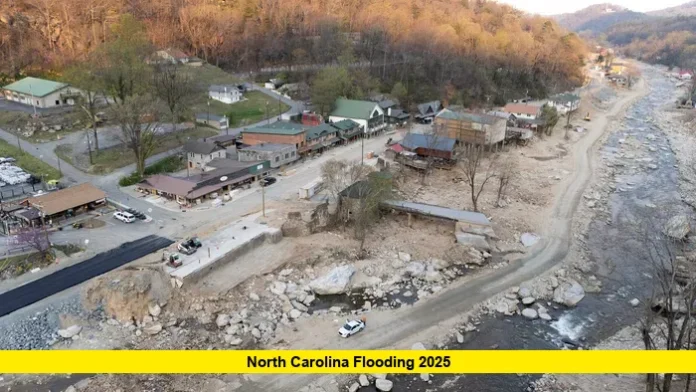As of July 2025, North Carolina flooding has once again become a major concern following the remnants of Tropical Depression Chantal, which brought historic rainfall and widespread disruptions across the state. Emergency crews, local governments, and residents are responding to the latest crisis, while long-term flood reduction and resilience projects are being accelerated to address the increasing frequency of such events.
Historic Rainfall and Immediate Impact: North Carolina Flooding 2025
The first week of July 2025 saw North Carolina flooding reach critical levels, particularly in central regions. The remnants of Tropical Depression Chantal made landfall as a tropical storm near Litchfield Beach, South Carolina, early Sunday morning before moving northward through North Carolina. Some locations received up to nine inches of rain in just 24 hours, overwhelming rivers and washing out roads.
Hundreds of roads in central North Carolina were inundated, with the Eno River near Durham rising an astonishing 24 feet in less than 12 hours, surpassing 258 feet early Monday. Firefighters performed numerous water rescues in Chapel Hill, and a state of emergency was declared in Orange County as evacuations and emergency operations intensified. Chatham County reported over 100 roads flooded, including the collapse of State Highway 902. Flash Flood Warnings remain in effect for several counties, including Caswell and Halifax, as rivers continue to swell and saturated soils struggle to absorb additional rainfall.
Key Point Summary
- Up to 9 inches of rain fell in 24 hours in some areas.
- Hundreds of roads flooded; major river rises recorded.
- Multiple water rescues and evacuations; no deaths reported.
- Flash Flood Warnings ongoing in central and northern counties.
Ongoing Risks and Forecasts: What’s Next for North Carolina Flooding 2025
Although Tropical Depression Chantal has weakened, the risk of flash flooding remains high. The National Weather Service and Weather Prediction Center have warned that saturated soils and swollen rivers could lead to further flooding, especially in low-lying and urban areas. Rainfall totals of 2 to 6 inches are forecasted in affected regions, with the threat extending into Virginia, Maryland, and Delaware as the storm system moves north.
Residents are urged to avoid travel on water-covered roads and to stay alert for rapidly changing conditions. The Atlantic hurricane season is just beginning, heightening concerns that additional storms could exacerbate the situation. Emergency management officials emphasize preparedness, urging communities to heed advisories and prioritize safety.
Long-Term Solutions: Flood Reduction and Resilience Projects in 2025
The North Carolina flooding 2025 crisis underscores the urgency of ongoing flood resilience efforts. This year, the state is launching nearly 280 flood-reduction projects through the Streamflow Rehabilitation Assistance Program (StRAP), funded by the North Carolina Department of Agriculture and Consumer Services. These projects focus on removing stream debris, restoring eroding banks, and repairing dams to improve drainage and reduce flood risk.
An additional $22 million has been allocated to the Flood Resiliency Blueprint, a comprehensive initiative by the Department of Environmental Quality (DEQ) aimed at building a more flood-resilient North Carolina. The Blueprint targets six priority river basins and supports projects that enhance flood modeling, develop decision-support tools for local governments, and implement river basin action strategies. Early investments have already led to the completion of 54 resilience projects, with more underway.
Key Point Summary
- 280 flood-reduction projects approved statewide in 2025.
- $22 million invested in the Flood Resiliency Blueprint.
- Focus on data-driven strategies, improved modeling, and community partnerships.
Coastal Flooding: A Growing Challenge Beyond Storms
Recent research from North Carolina State University reveals that coastal flooding is occurring far more frequently than previously measured by federal tide gauges. Land-based sensors in communities like Beaufort, Carolina Beach, and Sea Level detected dozens more flooding days than official records indicated, highlighting the daily challenges faced by coastal residents even outside of major storms. This “sunny day flooding” is driven by rising sea levels and aging infrastructure, adding to the urgency for comprehensive flood mitigation.
Community Response and the Path Forward
The North Carolina flooding 2025 emergency is a stark reminder of the state’s vulnerability to extreme weather events. Local governments, emergency services, and residents have mobilized rapidly, with no reported fatalities thanks to swift action and improved preparedness. However, the scale and frequency of flooding events are prompting calls for continued investment in infrastructure, updated floodplain mapping, and stronger climate resilience measures.
As the Atlantic hurricane season continues, North Carolinians are bracing for further challenges. The state’s commitment to resilience, backed by significant funding and innovative projects, offers hope for reducing future risks and ensuring communities can recover more quickly from disasters.
Stay tuned for the latest North Carolina flooding 2025 news and exclusive updates on flood resilience efforts. Share your thoughts in the comments—how has flooding impacted your community?
